1 Introduction
Global environmental change poses complex threats to health and livelihoods, and food security is one of the major impact pathways (Lam et al., 2022). In addition, the effects of increased temperature, erratic rainfall, frequent floods, and prolonged droughts due to climate variability and change have negatively impacted agricultural productivity in the SSA region (Serdeczny et al., 2017; Adolwa et al., 2023). The Sixth Assessment Report of the IPCC reiterated unequivocally that greenhouse gas emissions from anthropogenic activities warmed the atmosphere, ocean, and land (Intergovernmental Panel on Climate Change, 2023; Lee et al., 2023). In Africa, it is projected that global warming over the next century will increase with an average of 3–4°C, which is expected to be above the global annual mean (Boko et al., 2007; Thompson et al., 2010). SSA in particular will experience intermittent high rain intensity (Christensen et al., 2007; Thompson et al., 2010). This will be in addition to existing sensitivity to rain variability in SSA because of the predominance of rain-fed agriculture in the region (Omotoso et al., 2023). Climate change is one of the biggest threats facing humankind today and is already having adverse impacts particularly in rural areas where the majority of the population (67%) lives and mainly depend on agriculture-based livelihoods (Adger et al., 2003; Dube and Phiri, 2013; ZIMSTAT, 2013; IPCC, 2014; Apraku et al., 2018a,b; Phiri et al., 2019). Urban agriculture is gaining more attention because of the current global trends such as urbanization and the global economic and food crisis (Mthethwa, 2012). Continuing rapid urbanization suggests that the conversion of agricultural lands for urban uses will proceed rapidly into the foreseeable future (United Nations, 2018; Andrade et al., 2022). In Sub-Saharan African (SSA), climate change, urbanization, and population growth are aggravating the challenges to agricultural development (Balogun et al., 2022). Urban agriculture is an important economic activity, which needs to be well-understood, especially in the context of African cities facing triple problems of high population, food insecurity, and poverty (Nchanji and Nchanji, 2022).
Smallholder farming systems in sub-Saharan Africa are highly diverse, and farm typologies have proven useful in identifying farms with different levels of resource endowments and livelihood strategies (Tittonell et al., 2010; Vasco Silva et al., 2023). Rural smallholder households adopt indigenous strategy to cope with short-term changes as a self-regulatory mechanism (Speelman et al., 2014; Jha et al., 2023). The increased effects of climate change among smallholder farmers call for enhanced adoption of adaptation and mitigation measures that result in improved food security (Ndiritu et al., 2014; Kimaru-Muchai et al., 2020; Musafiri et al., 2020, 2022). Coastal communities face increasingly difficult decisions about responses to climate change (Sherren et al., 2022). Nature-based coastal adaptation options go by many names. However, most studies on the vulnerability of agriculture focus on socio-economic indicators with little attention to the comparative analysis of smallholder crop production’s vulnerability to different environmental stressors. Poor documentation of environmental changes and their effects may contribute to poor governance and planning in the coastal region. Coping strategies were weak and overtly reactive, as there appeared to be no evidence of any previous plan for response to such degrading effects (Onanuga et al., 2022). The wide scope of climate change research and the diversity of scientific traditions involved in vulnerability research have resulted in different definitions and theoretical conceptualizations of the climate vulnerability phenomenon (Gumel, 2022). However, despite its importance for poverty reduction, small-scale market gardening in and around the large coastal cities of Africa and southern Benin has received very little research, development, and policy attention. Understanding the diversity of smallholder farms is key for developing interventions, strategies, and policies aimed at addressing the numerous challenges these farmers face as well as for those shaping the future of smallholder farming (Kamau et al., 2018) in Benin, Africa, and beyond. Understanding the impact of commercial agriculture in the face of global change is critical to support strategies that ensure food security and alleviate poverty among households (Mwavu et al., 2018).
The main objectives of the study were to (i) characterize smallholder vegetable farms along the coastal area of Benin, (ii) understand the ongoing environmental changes, and assess farmer’s perception and coping strategies in the urban and periurban areas. This study was designed to clarify the functioning of vegetable production systems in the peri-urban area of southern Benin and their adaptation to urbanization and climate change. As a result, this paper will develop strategies for adapting and mitigating environmental change in peri-urban areas, which can be adapted and replicated.
2 Materials and methods
2.1 Study area
The coastal area of Benin is situated in the Gulf of Guinea, alongside the Atlantic Ocean in West Africa and extends between 1° 44′ 30″ and 2°37′00″ eastern longitude and between 6° 15′ 50″ and 6°44′ 85″ northern latitude. The study area encompasses four (04) of the country’s 12 departments (Atlantic, Littoral, Ouémé and Mono). The Atlantic Department is the most populated, with about 1.4 million inhabitants according to the last population census 2013 (INSAE, 2015). Although the department of Mono is one of the least populated with about 497,200 inhabitants, the municipality of Grand-Popo has an annual population growth rate is higher than the national average of 3.5% (INSAE, 2015). Based on information collected from the “Direction des Statistiques Agricoles,” (DSA, 2022) but also because of the presence of a high number of market gardeners in the coastal zone, the five municipality of Sèmè-Kpodji, Cotonou, Abomey-Calavi, Ouidah and Grand-Popo were selected for this study (Table 1; Figure 1). The climate is subequatorial, with two rainy seasons alternating with two dry seasons of unequal duration, with average annual rainfall ranging between 1,000 and 1,400 mm (Yassegoungbe et al., 2022). The mean temperature ranges from 31.5 to 33°C (Teka et al., 2019). Soils are sandy, hydromorphic, and ferralitic (Ahouangan et al., 2022).
Table 1. Demographic characteristics of the studied municipalities (INSAE, 2015).
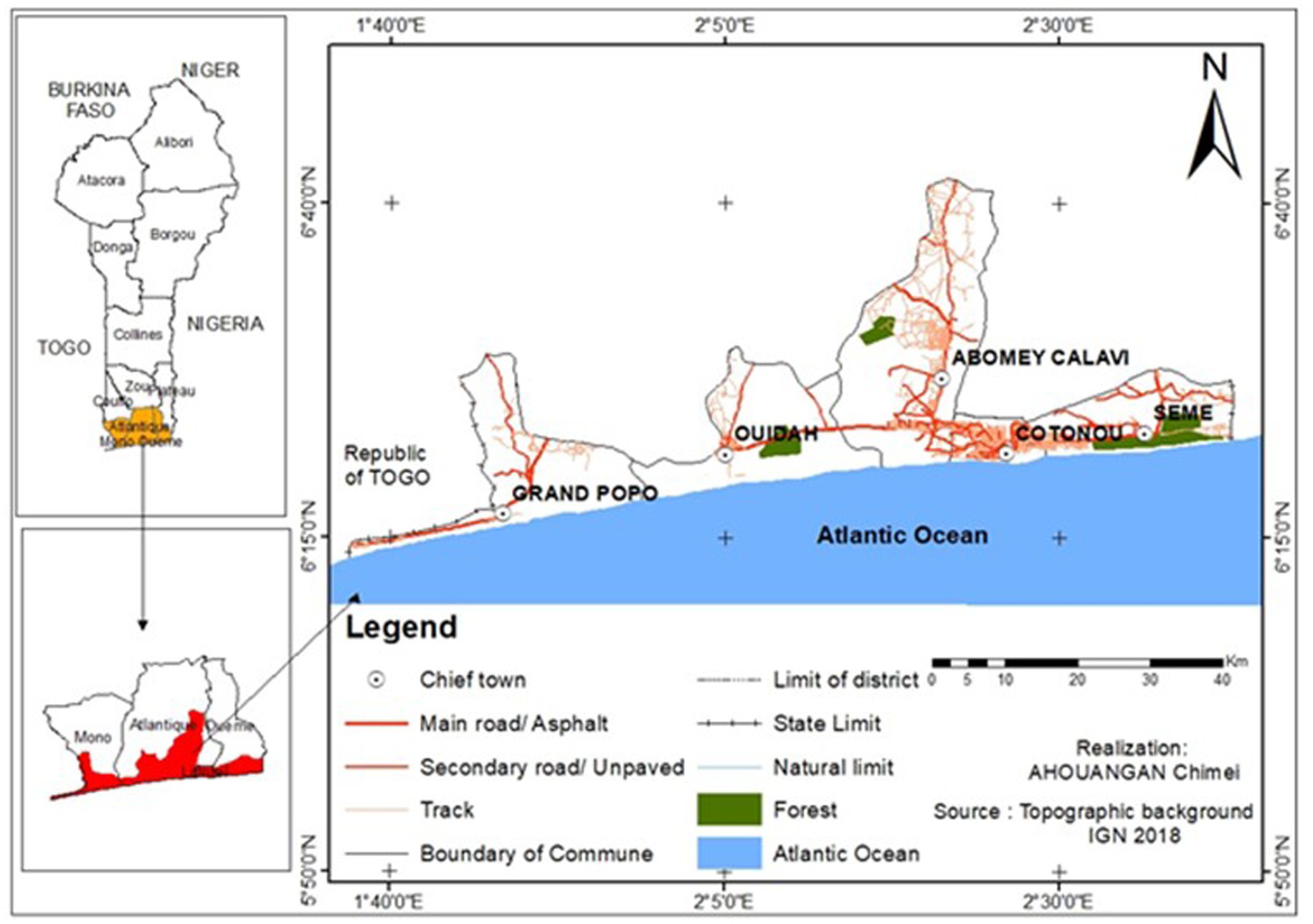
Figure 1. Study location map.
Vegetation consists of shrubs, plantations, grasslands and mangroves on the coastal belt and semi-deciduous dense forests on the soil bar plateau (Akoègninou et al., 2006) and coconut plantations along the coastal belt (Koura et al., 2015a,b). The economic activities practiced are agriculture, fishery, livestock rearing, salt production, trading, marine sand exploitation, and hunting (Teka et al., 2019). Small-scale farmers depend mainly on agriculture as their mainstay of livelihoods (Kom et al., 2022).
2.2 Data collection
This study was carried out among small-scale market gardeners along the coastal area in southern Benin. The methodological approach adopted was a combination of qualitative and quantitative research methods. A total of 130 vegetable farms were visited in the study area (Table 2). The sample was selected using the snowball sampling method (Noy, 2008). This method was chosen because there was no pre-established list of market gardeners for the five municipalities, and contacting them without going through their peers was difficult. The sampling of market gardeners was facilitated by collaboration with the livestock agents of the “Agence Territoriale pour le Développement Agricole (ATDA4),” and the support of some association or cooperative leaders in each locality, who helped to identify market gardeners. Only those market gardeners who were identified and agreed to participate in the survey (oral consent) were interviewed. Information on vegetable farms that did not respond to the interview was discarded. Data were collected at the farm level from the head of the household (male/female) through face-to-face interviews using a semi-structured paper questionnaire. Qualitative and quantitative information collected included household characteristics (ethnic group, age and gender structure, education levels, main activities, access to media and agricultural credit), main sources of household income, market gardening experience and training received, crops, labor related to market gardening, use of manure, use of crop residues, land ownership and land use. Prior to its administration, the questionnaire was pre-tested with 05 market gardeners in the municipality of Grand-Popo who were not included in the survey, and the questions were revised if necessary. In each locality, the questionnaire was administered in French and translated into the local language by an experienced enumerator, recruited as a guide and trained for this task.

Table 2. Distribution of sampled farms across the four municipalities.
Furthermore, meteorological data (Mean annual temperature and precipitation from 1982 to 2020) were collected from the “Agence Nationale de la Météorologie du Bénin (METEO-BENIN).”
2.3 Data analysis
2.3.1 Typology of smallholder market gardening systems
To characterize smallholder market gardening systems, we first realized an initial descriptive statistical analysis of all the variables investigated in the study. Means and standard error were computed for numerical variables, while proportions were calculated for categorical variables. The second step consisted of reducing variables to get only the most relevant ones. Among the four quantitative variables of the dataset, there was only one variable with a coefficient of variation r > 90%) with others were removed from the dataset (Ibidhi et al., 2018). Regarding qualitative variables, we first eliminated the ones with modalities scoring more than 70%. This was followed by the computation of the cramers’V phi coefficient. Only the variables with
φ
c
90
%
were kept. The reduced dataset was composed of 19 categorical variables and 5 quantitative variables. Hierarchical clustering on principal components (HCPC) was realized on the reduced dataset to make the typology of market gardening systems. The HCPC used a factorial analysis on mixed data (FAMD) results to perform the clustering. Different groups were identified, related to individuals, and characterized by the explaining variables. These analyses were realized using the package FactoMineR (Lê et al., 2008). Fisher’s exact test was used to investigate the relationship between the clusters of market gardeners and the qualitative variables. All the analyses were performed with R software version 3.6.0 (R Core Team, 2019).
2.3.2 Dynamic trend of climate
The climate change along the coastal area of southern Benin in the Southern of Benin has been assessed by firstly showing the variation of the Mean annual temperature and precipitation from 1982 to 2020 for each of the four regions, namely Cotonou, Grand-Popo, Ouidah, Sèmè-Kpodji. The climatological network in the area is made up of a synoptic station (Cotonou-airport for the municipalities of Cotonou and Abomey-Calavi), a climatological station (Ouidah) and two pluviometric stations (Sèmè-Kpodji and Grand-Popo) Then the Package “ggplot,” “ggpubr” (equation trend), “dplyr” (summarize the Daly data to annually) had been used on the R-4.0.5 software to perfect the XY plot. Secondly, the coastal changes responding to climate change have been characterized by the standard precipitation-evapotranspiration index (SPEI). It has been performed thanks to the package “SPEI” in R. This climatic index is widely used for drought quantification and monitoring. Given a time series of the climatic water balance (precipitation minus potential evapotranspiration), gives a time series of the Standardized Precipitation-Evapotranspiration Index (SPEI). The functions standardize a variable following a log-Logistic (or Gamma, or Pearson III) distribution function (i.e., they transform it to a standard Gaussian variate with zero mean and standard deviation of one). A part from this index, the changes in the Mean annual value of extreme climate indices had been computed with the package R-Climdex. The indices calculated and plotted are the Maximum Consecutive Dry Days, the Maximum Consecutive Wet Days, the Maximum Consecutive Wet Days, the Total Daily Precipitation, the annual Maximum 5-day Consecutive Precipitation, the Percent of Values Above 90th Percentile Daily Minimum Temperature. In this study, two nonparametric methods (Mann–Kendall) were used to detect the trends of meteorological variables (Nourani et al., 2018). The choice of total daily rainfall over 5 consecutive days is based not only on the experience of the market gardeners, but also on the soil formations whose structure favors flooding of the market garden perimeters after 5 consecutive days of rain. Trend analysis and the Mann–Kendall (M–K) test method were applied to investigate the change trend and period of drought based on an arithmetic mean value of annual drought, respectively (Mann, 1945; Kendall, 1975; Nourani et al., 2018). The Mann–Kendall trend test, which is highly recommended for general use by the World Meteorological Organization, were used to characterize the trends for several precipitation-related indices and to test their significance. The rank-based Mann– Kendall method is a nonparametric method commonly used to assess the significance of monotonic trends in climate data (Zhang et al., 2009).
2.3.3 Farmers’ perception and adaptive capacity
Farmers reported three general types of perceptions of climate change. These include the observed causes of climate variability, the impact of climate on smallholder production and the effect of climate on crop performance. For each category, the data included one response variable, the market gardener group, and many independent variables. Tree classification models using conditional inference (Hothorn et al., 2006) were used to study the influence of factors related to respondents’ perceptions on the group selected by the farmer. Statistical software R version 3.6.2 (R Core Team, 2019) was used for all statistical analyses with a significance level of 5%. The R package partykit (Hothorn and Zeileis, 2015) was used to perform the models of conditional inference trees and package strucchange (Zeileis et al., 2002) was used to extract the test statistics and p-values computed in each node. Cross-tabulations and chi-square statistics were used for current and future coping strategies to analyze the relationship between farmer’s groups and the strategy adopted.
3 Results
3.1 Socio-economic characteristics of market gardeners in the coastal zone in southern Benin
Market gardeners in the coastal area of southern Benin have many similarities in terms of their socio-economic characteristics, including their age (mean age 42.68 ± 1.22), religion, household size, main activity, and source of income. The respondents were 80% men, most of them married, and 20% women. The most represented socio-cultural groups are the Adja (68.46%), followed by the Fon (17.69%). The majority of these respondents are literate (50.77%), 23.08% of whom are secondary school graduates. Their main occupation is market gardening (69.23%).
3.2 Typology of market gardening farms in the coastal region
The results of the HCPC showed that the variables contributing the most to the farm classification were the ethnicity group, the municipality of origin and the religion (Table 3). Variables related to the production site, municipality of origin, ethnicity, religion, education level, access to information, length of time in the environment, socio-cultural identity as a motivator, watering method, ownership of animals for crop residue use, and household organic farming practices were closely related to the different groups of small-scale vegetable farms. Variables such as part-time on-farm labor, ecology of the growing area, land area, cultivation of okra and black eggplant, crop income and other sources of income did not appear to provide much additional information for the HCPC but were retained to meet the criteria for explaining 90% of the farm variability. The results of the hierarchical clustering procedure suggested a three-cluster cut-off point, illustrated in the clustering dendrogram, and a bar chart showing maximum dissimilarity between clusters with an increasing grouping of observations (Figure 2). However, the variables of part-time on-farm labor, the ecology of the cropping area, the cultivation of okra and black eggplant, land area and other sources of income were excluded from the definition of farm types because there were no significant differences (p Table 3). Regarding the quantitative variables, only age contributed to the differentiation of farm groups (Figure 2).
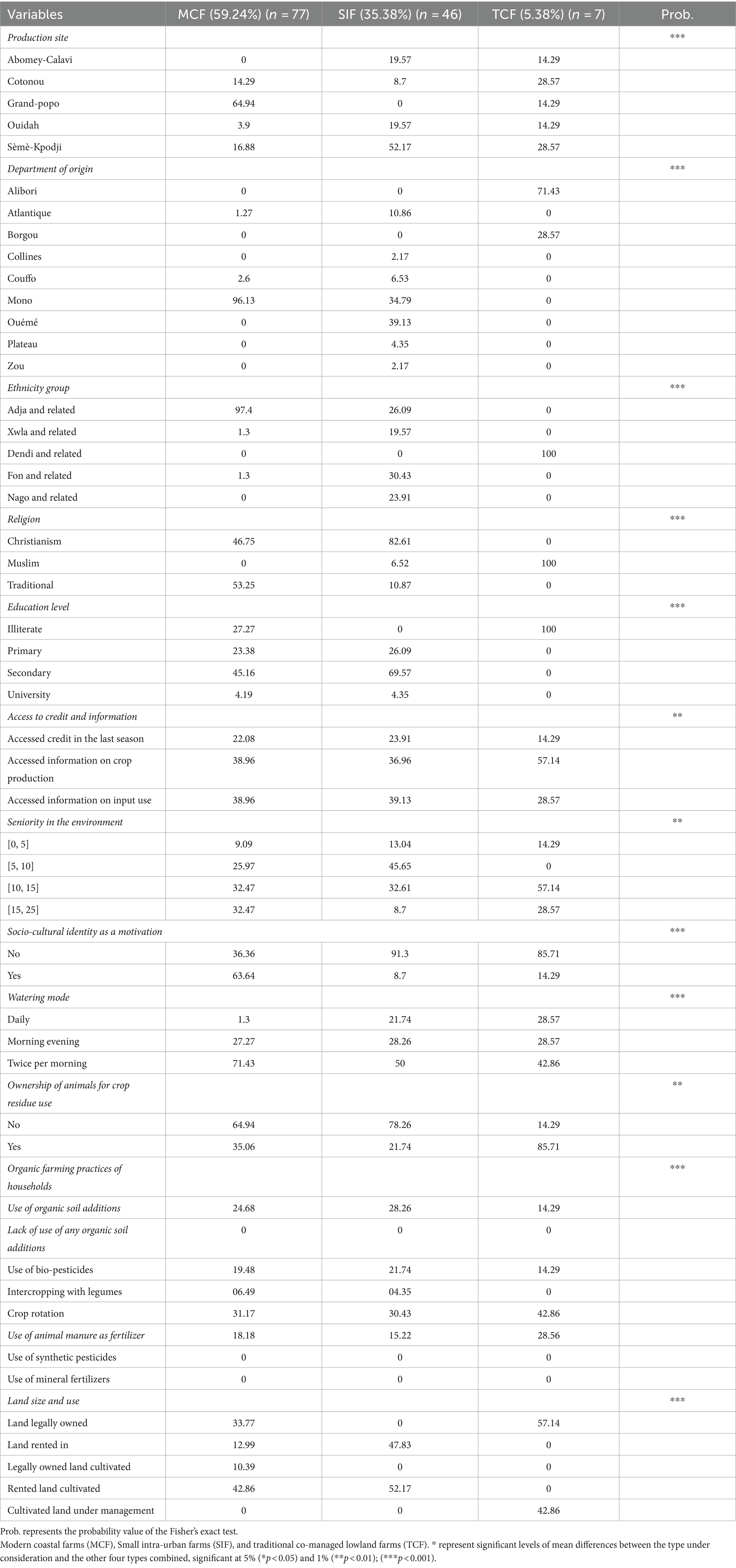
Table 3. Qualitative characteristics of the three clusters of market gardeners.
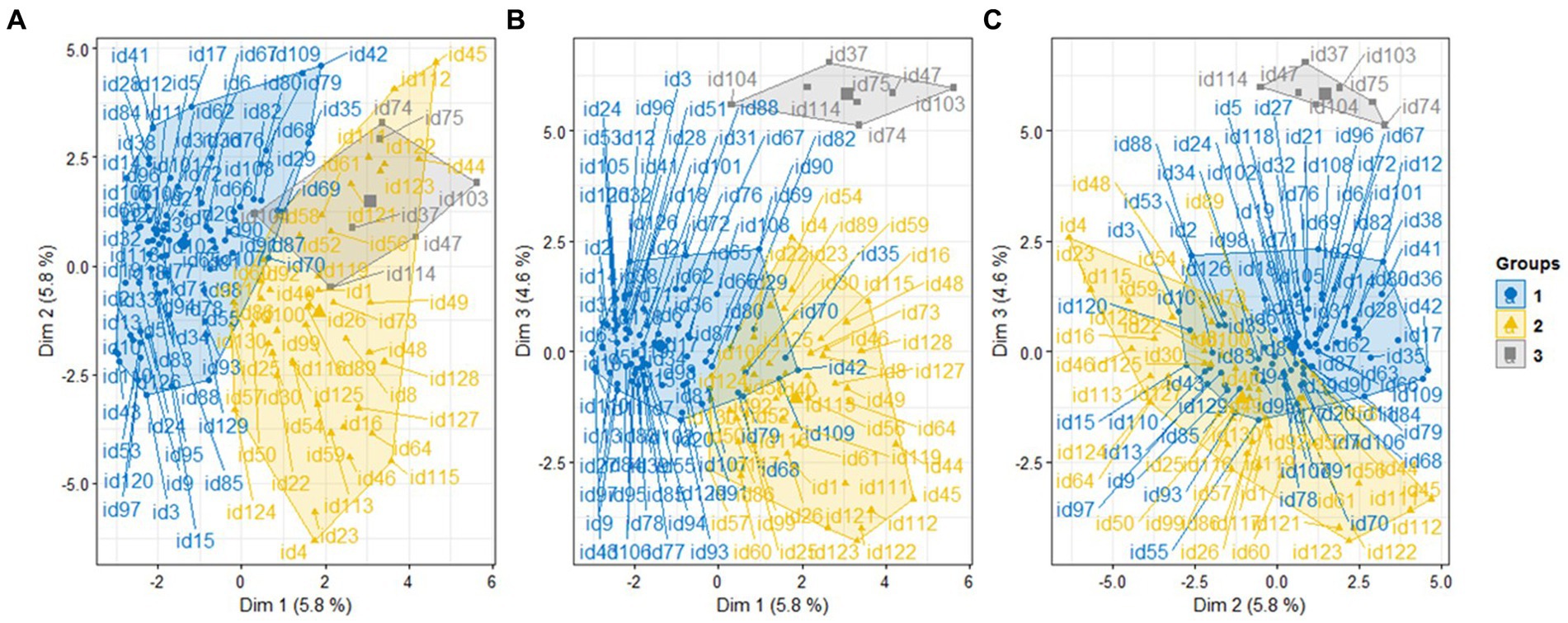
Figure 2. Clustering of the market gardening practitioners into three groups on (A) the first two axes, (B) the first and third dimensions and (C) the second and third dimensions.
The cluster analysis (HCPC) suggested three distinct types of farming systems, referred to as modern coastal farms (MCF; 59.24%), small intra-urban farms (SIF; 35.38%), and traditional co-managed lowland farms (TCF; 5.38%).
The following section describes the characteristics of the three farm types in detail, while Table 1 provides a summary.
3.2.1 Group 1 modern coastal farms (MCF)
Low resource endowment, mainly ‘organic by default’ and self-subsistence-oriented agriculture with large households where the education level of the head of household reaches a secondary level, site located in rural areas and diets are the least diversified (59.24% of farms assessed). This group includes rather small farms, with the lowest levels of farm income, the lowest levels of use of crop residues for livestock feed (especially cattle), high dependence on family labor (members work the least outside the farm) and socio-cultural identity as a source of motivation. This group of smallholder vegetable farms is also characterized by the fact that most farmers are indigenous (64.94%), and the land is either owned by families (20.68%) or rented for cultivation (39.09%); a rather strong adherence to intercropping with legumes, watering twice a morning with high levels of crop rotation and use of biopesticides. However, they mainly used organic inputs to the soil, such as manure, compost, and recycled plant residues, with most households adding some form of organic amendment to the soil. Their use of synthetic pesticides was insignificant. These households had the highest number of members compared to the other clusters. They had the lowest access to information on agricultural production, however they had access to information on inputs. In addition, they were primarily practicing traditional religion and had been residing in the coastal perimeter for more than 15 years. Finally, they generally belong to associations or cooperatives located on the coast and have the lowest levels of dietary diversity.
3.2.2 Group 2 small intra-urban farms (SIF)
High equipment and resource endowment, mixed conventional and organic market orientation, most educated and literate farm managers (69.57% secondary and 04.35% tertiary level), most diversified diets, abundant non-farm activities (35.38% of farms assessed). Group 2 farming households are located in urban and peri-urban areas and are characterized by the non-existence of legal land as the cultivated land is rented (48.64%), the motivation for market gardening does not come from socio-cultural identity, however they have the highest levels of income from non-agricultural employment or business and not from crops. They rent large shares of land and have the most productive assets. In addition, these households have the highest level of soil organic matter input, use of biopesticides and access to agricultural inputs. However, they had a low level of exploitation of crop residues for livestock feed, low use of dung for soil fertilization and low levels of access to credit in the previous season. This group comprised a mixture of farms, some of which were organic and others conventional. The group was also characterized by farm households with family members working mainly off-farm (the least full-time work on the farm), and by the most educated and literate household heads. Finally, most of them were non-native and had been in the area for about 10 years, these households were heavily involved in social networks with the highest level of membership of various groups, for example, farmers’ cooperatives and associations, and women’s and youth groups.
3.2.3 Group 3 traditional co-managed lowland farms (TCF)
With very little equipment and resources, the farm is managed by a private individual who lives outside the locality, is the head of a native Fulani household, and is mainly engaged in cattle rearing under coconut trees, and is generally illiterate (5.38% of farms assessed). Households in group 3 use market gardening as a means of subsistence and for consumption. These farms own cattle on large areas of land (at least 2 ha); and use family labor in farming activities, especially women and children in market gardening and milking cows. They represent the group with a high level of use of crop residues for feeding large livestock but also in the use of dung for soil fertilization. In addition, they periodically rotate crops but represent the group with the lowest level of biopesticide use. Most of the relatively young farm households have large land holdings entrusted to them by a legal landowner who is also the owner of the herd and plantation, but they generally use only a small part of their arable land to meet their subsistence needs because of the low level of ownership of farm equipment. Compared to the other groups they had a high rate of access to credit in the last season but the lowest rate of access to crops. Finally, they are generally not members of local social groups and are often absent from community meetings; they do not take advantage of the training provided by extension agencies; they often use small ruminants (goats, sheep) through community social arrangements to manage conflicts related to the destruction of the fields of neighboring populations by their livestock.
3.3 Climate change in the Southern of Benin
3.3.1 Changes in Mean annual temperature and precipitation
Figure 3 shows the trends of the Mean annual precipitation and temperature from 1982 to 2019. At first glance, we can observe a great variation of the precipitation and Temperature, but the p-values associated with Mann-Kendall test in Table 4 are not statistically significant for the precipitation, suggesting that there is no significant trend in the precipitation in whatever area considered. Although, the p-values associated with Mann-Kendall test in the table are statistically significant for the Mean annual temperature in whatever area considered (p-value
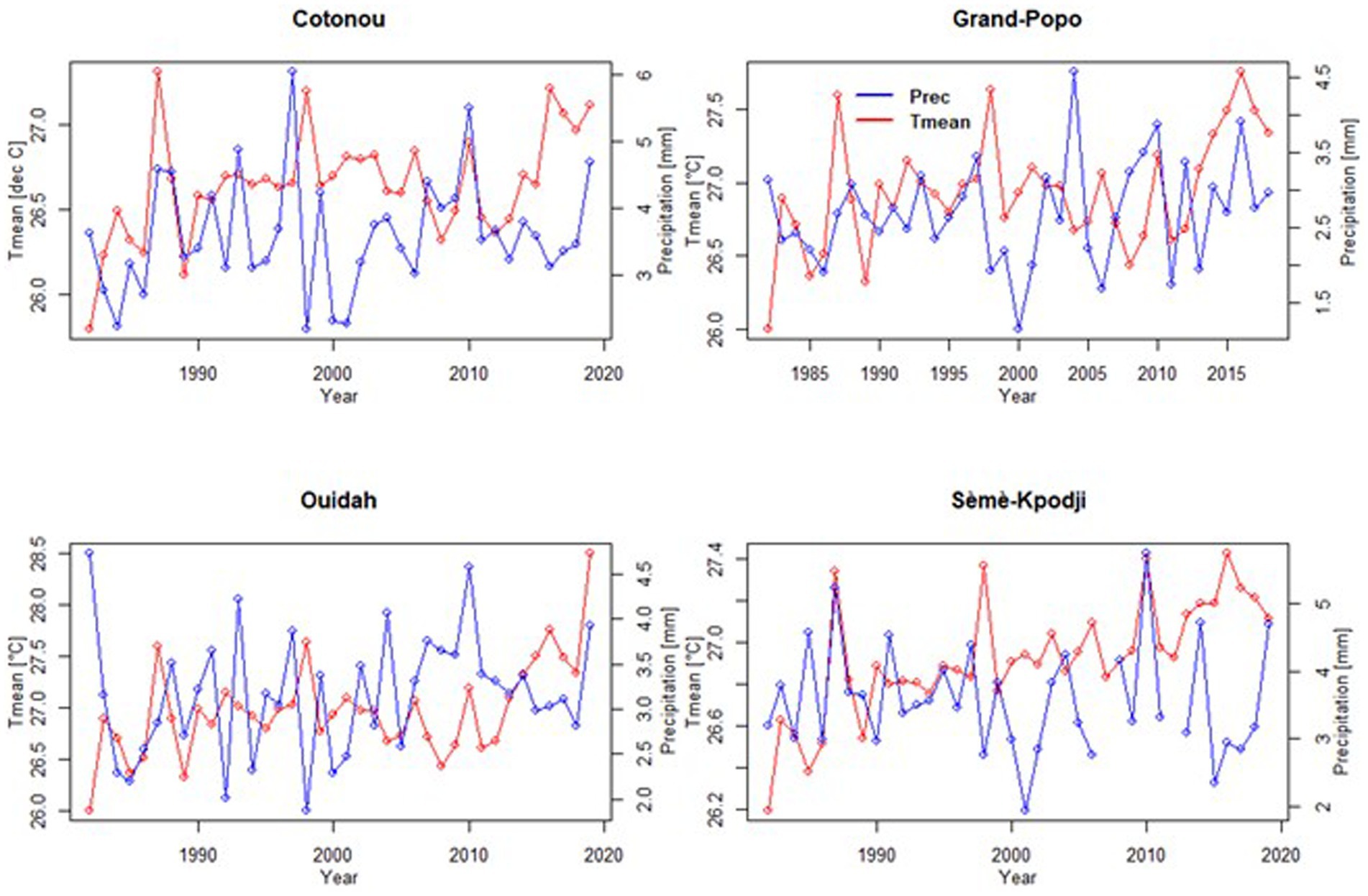
Figure 3. Changes in Mean annual temperature and precipitation.
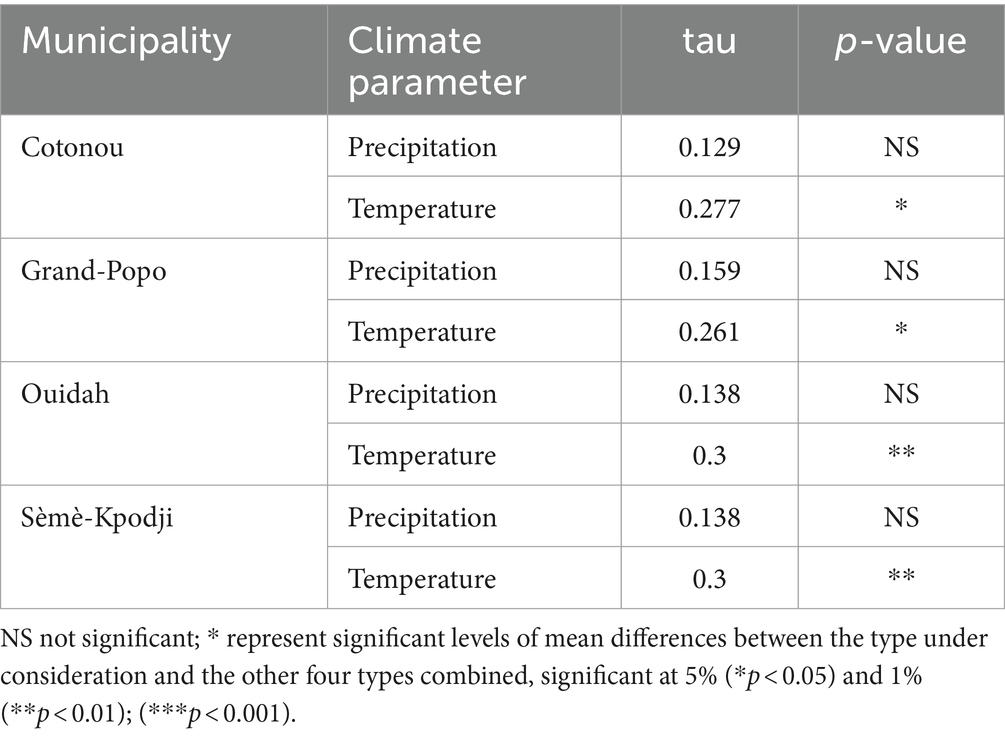
Table 4. Results of the Mann-Kendal test for Mean annual precipitation and temperature.
Annual rainfall patterns in Sèmè-Kpodji, Cotonou, Ouidah and Grand-Popo between 1982 and 2019 were characterized by high inter-annual variability with an average of 1267.45 mm; 1216.45 mm; 1083.9 mm and 941.07 mm, respectively. The surplus period covers years with a high frequency of wet years, while the deficit period corresponds to a relatively high frequency of dry years.
3.3.2 Coastal’s changes responding to climate change characterized by SPEI
Figure 4 shows the variation of the average annually value of the Standardized Precipitation-Evapotranspiration Index (SPEI) from 1982 to 2019. There is a frequent occurrence of drought periods. The longest period has been observed during the last 5 years. Exceptionally, in Sèmè-Kpodji, the 10 last year were marked by a Moderate drought.
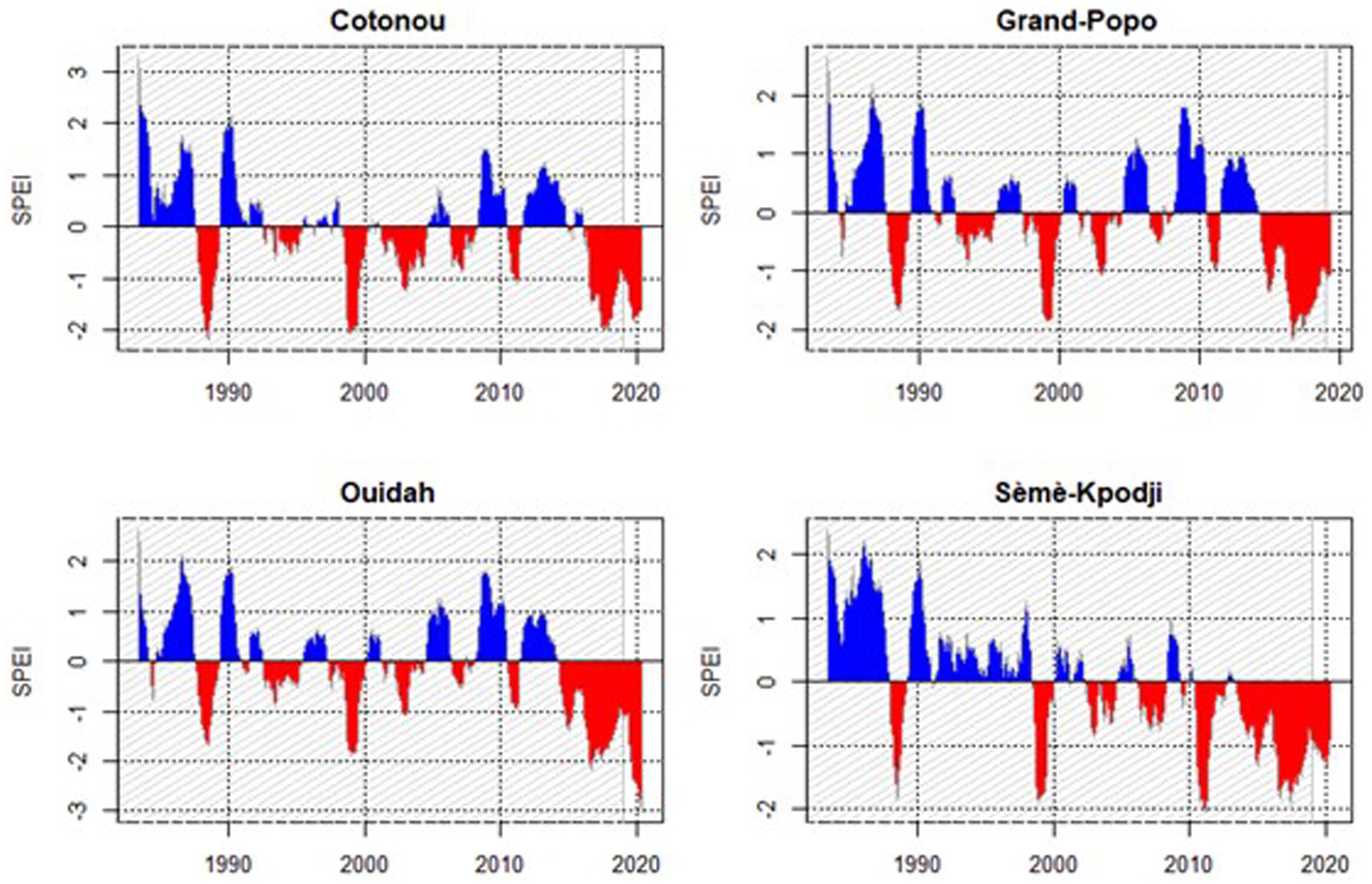
Figure 4. Variation of the average annual value of the Standardized Precipitation-Evapotranspiration Index (SPEI). SPEI sup 0 wetland; Inf 0 dryland.
However, analysis of the average annual value of the Standardized Precipitation-Evapotranspiration Index (SPEI) show that whatever the area considered, the SPEI decreased with years (Figure 5). These plots analysis, combined with Table 5, conclude that there is a significant downward trend in the SPEI data in southern Benin (p-value
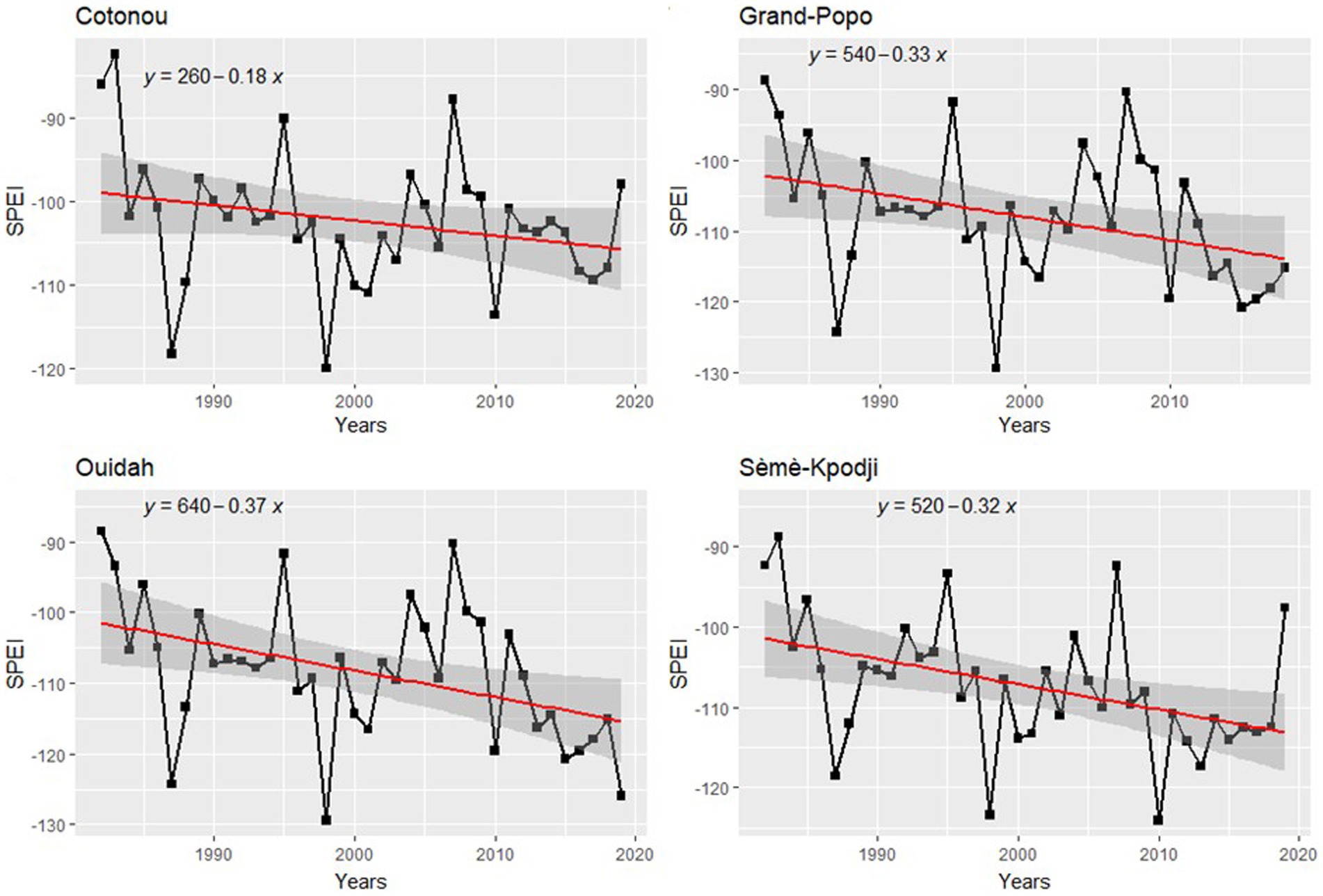
Figure 5. Variation of the average annual value of the Standardized Precipitation-Evapotranspiration Index (SPEI).

Table 5. The Mann-Kendall test result Mean annual SPEI.
3.3.3 Cold spell duration index
The cold spell duration index is the number of days each year that are part of a “cold spell.” A “cold spell” is defined as a sequence of 6 or more days in which the daily minimum temperature is below the 10th percentile of daily minimum temperature for a 5-day running window surrounding this day during the baseline period (Figure 6). Whatever the area considered; the Cold Spell Duration Index increased with the years. These plots analysis, combined with Table 6, allow to conclude that there is not a significant trend in the CSDI data (p-value >0.05).

Figure 6. Variation of the cold spell duration index.
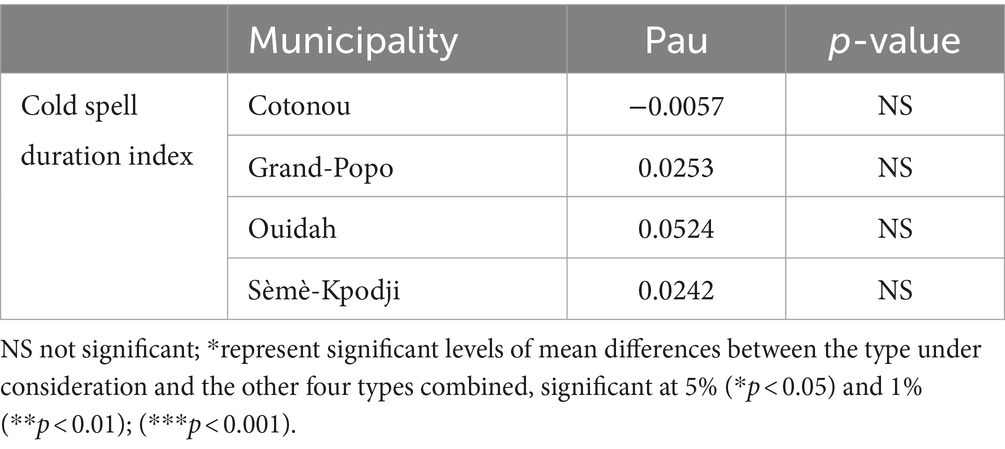
Table 6. Mann-Kendall test result for cold spell duration index.
This function inputs a climdex Input object and computes the climdex index Rx5day: annual maximum 5-day consecutive precipitation (Figure 7). The annual maximum 5-day consecutive precipitation decreased with years in the four areas. These plots analysis, combined with the Table 7, conclude that there is no significant trend in the annual maximum 5-day Consecutive Precipitation data (p-value >0.05) in Cotonou, Grand-Popo and Ouidah. In Sèmè-Kpodji area, there is a significant downward trend in the annual maximum 5-day Consecutive Precipitation data.
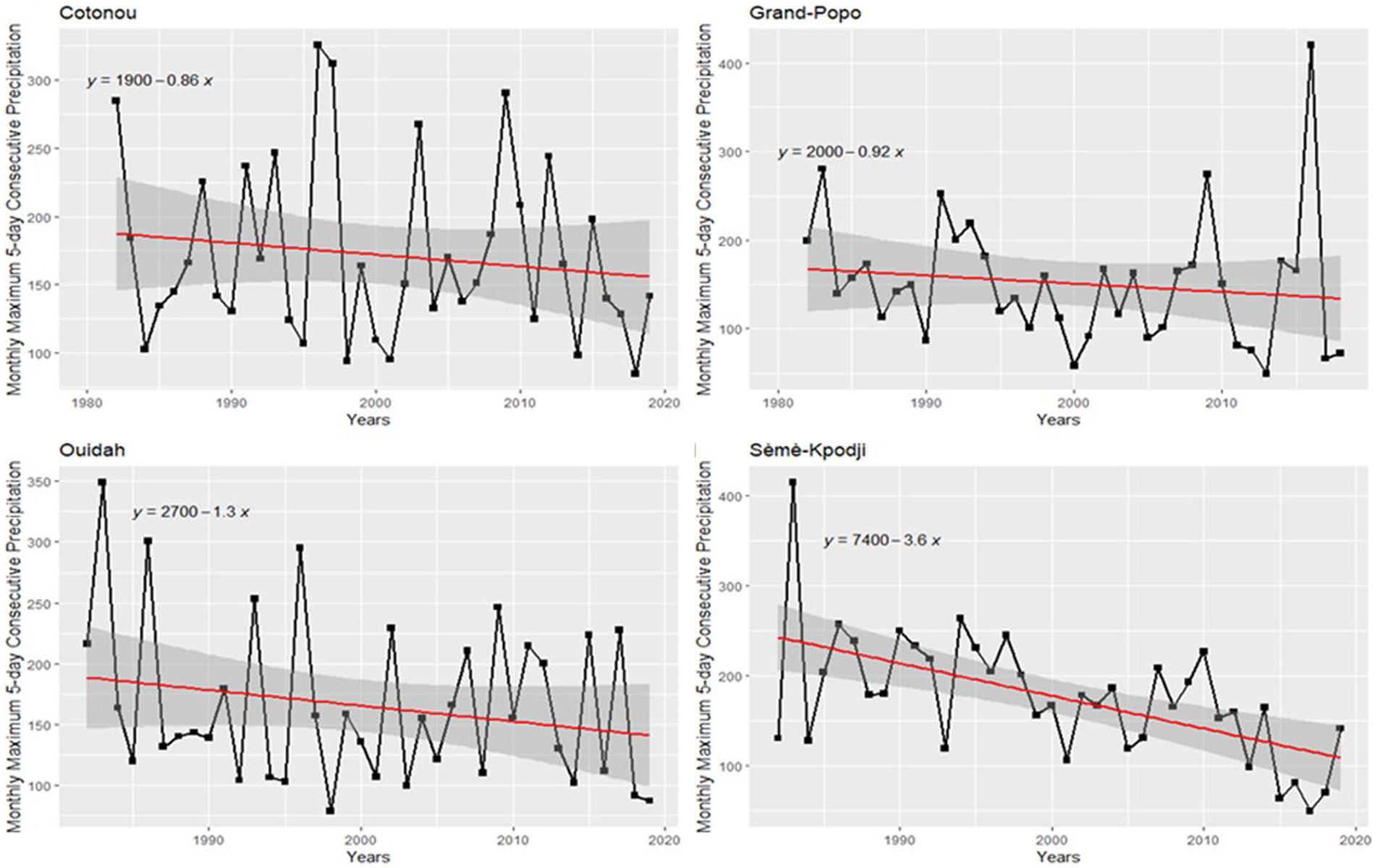
Figure 7. Variation of the annual maximum 5-day Consecutive Precipitation.

Table 7. Mann-Kendall test result for annual maximum 5-day Consecutive Precipitation.
3.4 Farmers’ perception of climate change
Most of the farmers perceive the ongoing climate change, and there were significant differences (p Figure 8). However, according to the three groups of smallholders, the perception of climate change depended only on the position of the production site, strong winds, and the beginning of the rainy season (Figure 9). This is confirmed by Fisher’s exact test (p value

Figure 8. Farmers’ perceptions of climate change in the coastal zone of Benin.
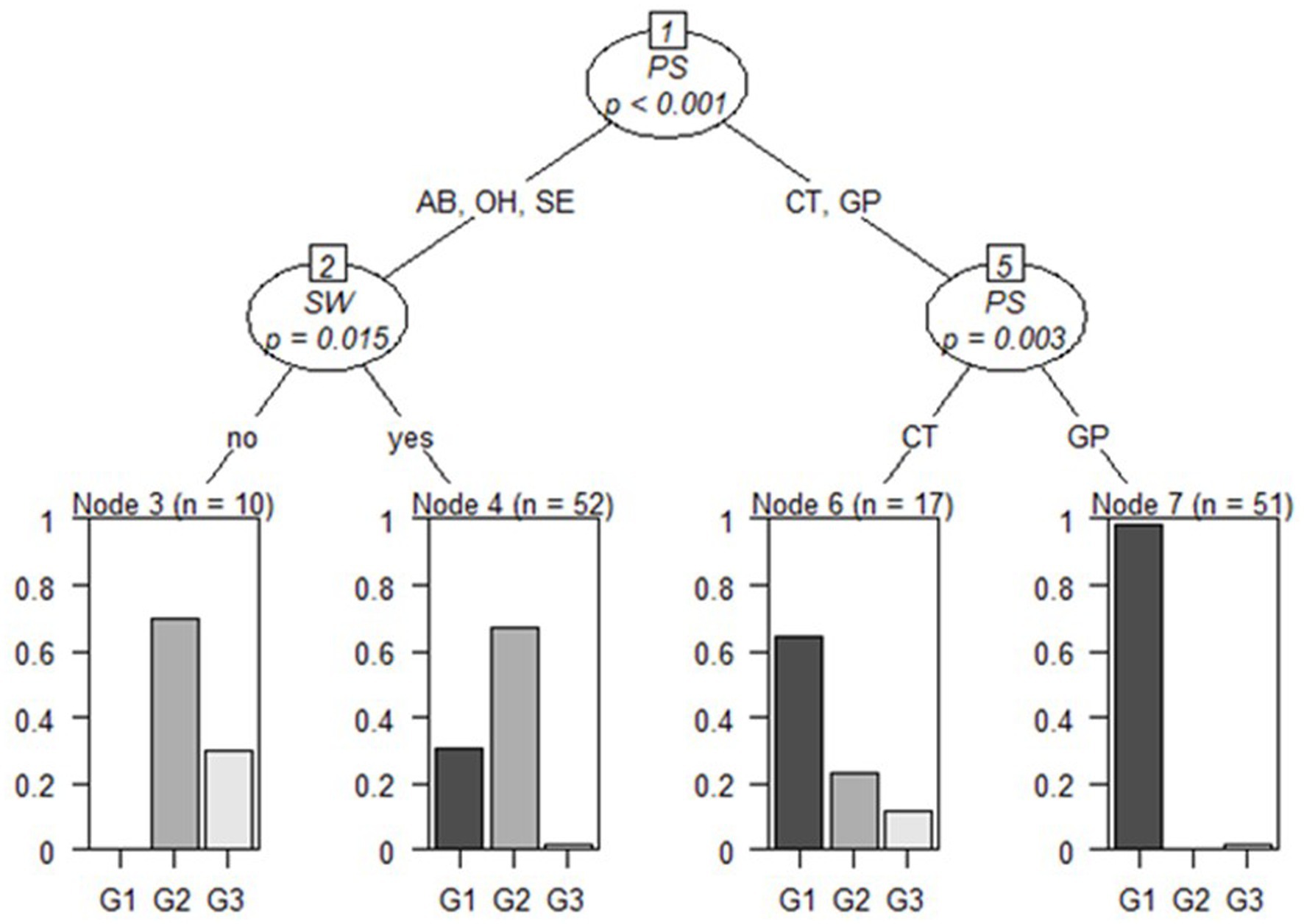
Figure 9. Conditional inference tree showing factors driving the change perception. PS, Production site; AB, Abomey-Calavi; OH, Ouidah; SE, Sèmè-KKpodji; CT, Cotonou; GP, Grand-popo; n, number of mentions; G1, group 1; G2, group 2; G3, group 3.
Informants who reported the presence of strong winds were mostly located in urban areas and belonged to groups 1 (31%) and 2 (67%). In addition, only the informants in group G1 (98%) perceived that the location of the production site in rural areas at the coast influences the yield of small-scale vegetable farms and their livelihood. The same observation was made by 65% of individuals in group G1, 24% in group G2, and 11% in group G3, who had their farms in urban areas.
Regarding the perception of the start of the rainy season, small-scale vegetable farms, 71% of individuals in group G2 and 27% in group G1 belonging to the same peri-urban area mentioned an early onset of the rainy period (Figure 10). On the other hand, only 98% of the respondents in group G1 belonging to the rural area mentioned that these changes are related to the position of their production site, and 65% of individuals in group G1 and 24% in group G2 belonging to the urban area, mentioned the same perceptions.

Figure 10. Conditional inference tree showing factors driving climate perception. AB, Abomey-Calavi; OH, Ouidah; SE, Sèmè-Kpodji; CT, Cotonou; GP, Grand-popo; n, number of mentions; G1, group 1; G2, group 2; G3, group 3.
Regardless of age, all individuals in the three smallholder market gardening groups (100%) indicated that they perceived some changes in crop production and yield.
The relative frequency with which respondents cited the perceived causes of these changes (Figure 11) was mainly natural hazards (87.15%), the displeasure of deities (81.69%), urbanization (75.38%), pollution (74.77%) and failure to meet social norms (69.88%).
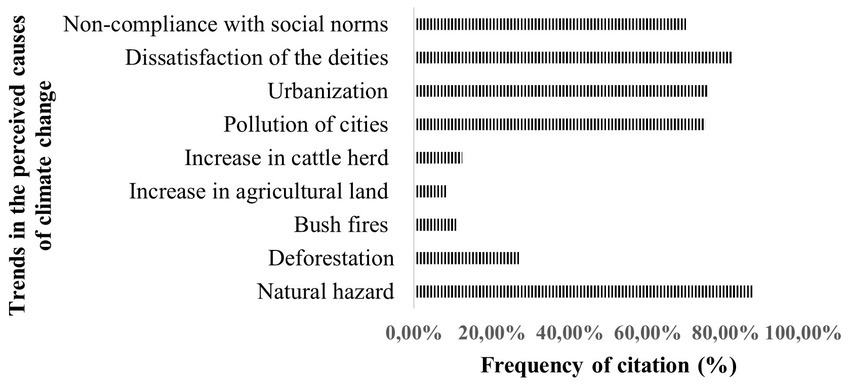
Figure 11. Farmers’ perception of the causes influencing climate change in the coastal zone.
The analysis of the effects of climate change on agricultural production at the level of the different groups of small-scale vegetable farms reveals that it affects the yield and performance of crops. According to the respondents, the consequences of these changes are mainly the recurrent plant pathologies (91.54%), as well as the decrease in crop yield, early rotting of fruits and vegetables (64.62%), and early ripening of fruits and vegetables (70.77%).
However, only the occurrence of plant pathological diseases could be used to distinguish between the groups and between the production sites. The conditional inference trees showed that only production site (PS) strongly associated with climate change’s consequences on production performance and crop yields. Informants whose production sites were located in peri-urban areas mentioned this consequence in groups G2 (68%) and G1 (26%). As well, 98% of the small farms in urban areas belonging to group G1 made the same observation, compared to 65% of this same group in rural areas and only 12% in the third group (Figure 12).

Figure 12. Conditional inference tree showing factors driving the perceived causes, the impact of change on production, the effect of change on performance. PS, Production site; AB, Abomey-Calavi; OH, Ouidah; SE, Sèmè-KKpodji; CT, Cotonou; GP, Grand-popo; n, number of mentions; G1, group 1; G2, group 2; G3, group 3.
3.5 Adaptive capacity
Fisher’s exact test revealed that only crop diversification (CD), migration (MG), and ritual organization (RO) were the current strategies on which the farmer groups depended (p value p value >0.05). Figure 13 presents farmers’ current and future coping strategies. Analysis of this figure reveals that the common current strategies of market gardeners are: migration to other farmland and the organization of rituals. Groups 1 and 2 adopt crop diversification, while group 3 does not. As for future strategies, all three groups most often mentioned the early sale of harvests and the use of more modern equipment. However, farmers in groups 1 and 2 plan to stop market gardening if climate change and urbanization continue to limit their activity.
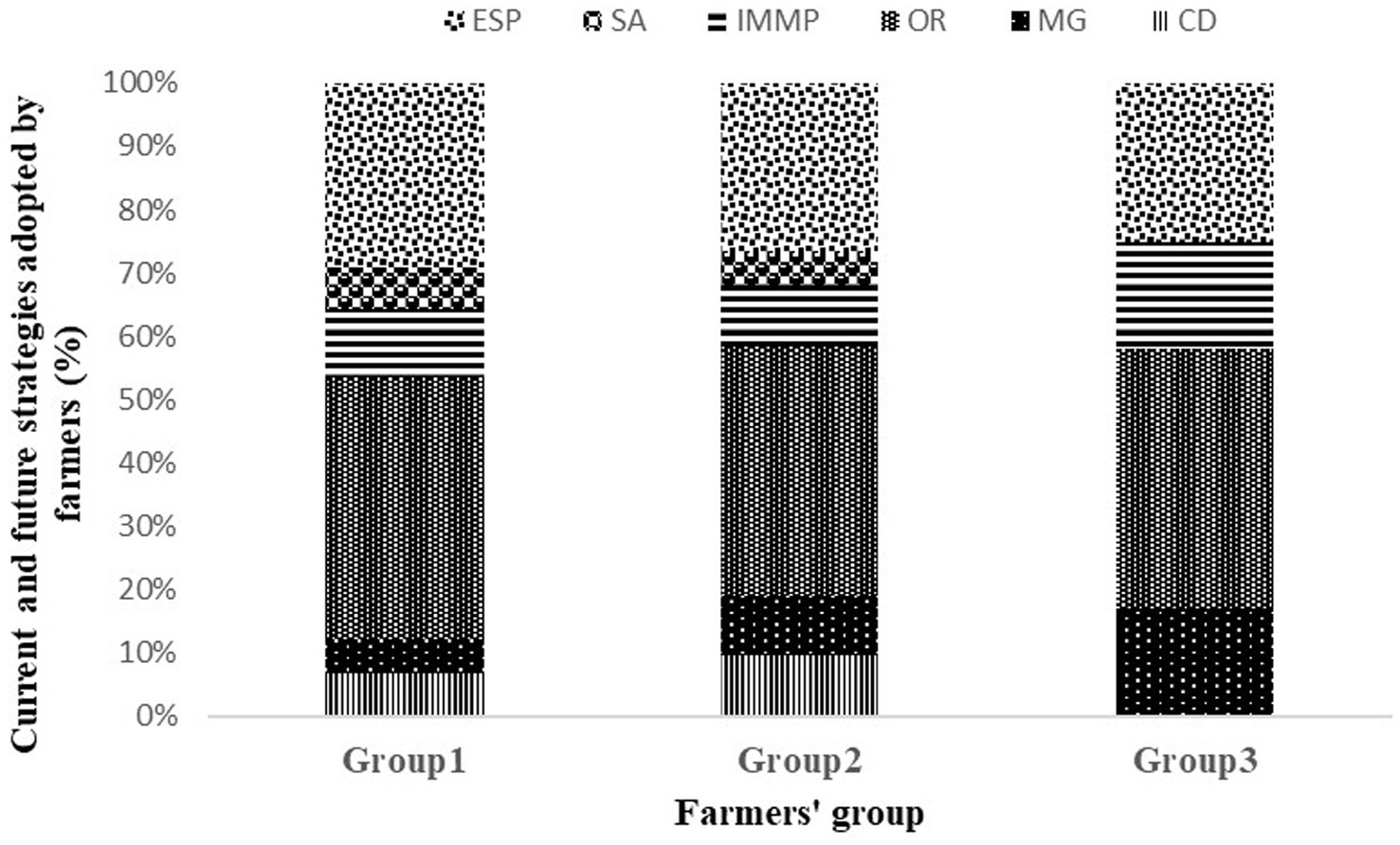
Figure 13. Frequency of farmers’ current and future strategies to overcome environmental constraints in southern Benin (n = 130).
4 Discussion
4.1 Typology of market gardening
The results indicate that only 20% of market garden farms in southern Benin are managed by women. This result reflects the low participation of women in vegetable production in the study area. This may be explained by women’s comparative disadvantage in terms of access to land, especially in an environment characterized by an increasing land shortage due to urbanization. The three types of market gardening systems obtained were clearly distinct, and this typology reflects the conditions of the restricted environment in which market gardening is practiced. The main discriminating variables are ethnicity, municipality of origin, and religion. Other factors contributing to the separation of groups are the production site, socio-cultural identity as motivation, level of education, and ecology of the market gardening perimeter. In southern Benin, the size of farms varies, and most of the farmers interviewed do not have land titles.
While Type 1 farms operate on the coast, Type 2 farms are located in urban and peri-urban areas, and Type 3 farms are located in the plains. Group 2 includes both coastal farms (e.g., Cotonou) and urban farms close to roads (Sèmè-podji). The area cultivated per farm varies greatly from one type to another. The largest farms belong to type 1 (1 ± 0.5 ha on average), which corresponds to the coastal zone (Grand Popo, Sèmè-podji), while type 2 corresponds to the intra-urban zone (Cotonou and Sèmè-podji). This result reflects the effect of land pressure, which is greater in intra-urban areas. Regarding land tenure, it is indirect at the level of type 1 and 2 farms (loan, rental), while type 3 farms are under direct land tenure (management for one owner). These results show that in addition to the scarcity of land experienced by type 2 farms and, to a lesser extent, type 1 farms, both types face the problem of land insecurity. These factors constitute serious obstacles to vegetable production in intra-urban and peri-urban areas. However, type 1 and 2 farms, generally grouped in cooperatives or associations, have a fairly good level of equipment and a wide variety of irrigation equipment: manual watering cans + wells + motor pumps + flexible connections (Cotonou, Sèmè-podji and Grand-popo). Type 3 farms, on the other hand, have a very low level of equipment. Grouping into cooperatives or associations of types 1 and 2 makes it possible to develop more or less intensive systems with more or less modern means, in contrast to type 3 which is based on (extensive) subsistence farming. Better still, their level of education, lack of access to the media, ethnicity and seniority in the region justify this low level of knowledge.
Several studies have used various criteria to describe local urban and peri-urban agricultural systems in different West African countries (Dossa et al., 2011). These are peri-urban, open space, and family farming systems. Drechsel et al. (2006), using production systems and destination of products close to location, distinguished between outdoor market gardening, backyard subsistence gardening, and livestock and aquaculture systems. Some studies have identified the age of the household head, remittances, and household size as determinants of food insecurity (Abdullah et al., 2017; Bhalla et al., 2018). These results differ from the results of these authors because at the coastal zone level and especially in Grand-Popo, market gardening is carried out under coconut groves, characteristic of agro-silvo-pastoral farms. However, these results corroborate those of Ouédraogo et al. (2018) in Burkina Faso, revealing that the farms are small. Moreover, membership in farmers’ groups is a positive element because, in Africa, socialities are essential to human survival (Seye et al., 2017) and, therefore, to livelihoods.
4.2 Farmers’ perceptions of climate change and urbanization
The results of this study on farmers’ perceptions of societal and environmental change in the coastal zone of southern Benin show that farmers are well aware of climate change and urbanization, as more than 90% of farmers surveyed perceived climate change and 87% perceived urbanization. Several studies in Benin, Africa and the world have already given similar results (Gnanglè et al., 2011; Rickards and Howden, 2012; Baudoin et al., 2013; Attingli et al., 2016; Mutunga et al., 2017; Concha, 2018; Meldrum et al., 2018; Kulyakwave et al., 2019; Lemi and Hailu, 2019). The main changes observed are rainfall disturbances (fewer days, delayed rainfall, early cessation, poor rainfall distribution, etc.), shortening of the two seasons, increased temperatures, sometimes strong winds, and other extreme events such as floods. Several studies in West-Africa have reported the same perceptions (Yegbemey et al., 2014; Assoumana et al., 2016; Adégnandjou and Barjolle, 2018; Oloukoi et al., 2019).
The results of the focus groups show that the main effects of climate change on agriculture were the increase in the number of pest attacks, the decrease in crop yields, the decrease in the quality of harvested products, the early rotting of fruits and vegetables, the loss of fruits and vegetables before harvest and the early ripening of fruits and vegetables. Indeed, all producers surveyed indicated that climate variability contributes to crop loss and lower crop yields. This is a situation that corroborates the fact that market garden production, which is highly dependent on water, is essentially marked by great seasonal variations that cause enormous damage to crops and, in turn, lead to a drastic drop in yields. Indeed, during the heading, flowering, and seed formation stages, which are the phenological stages during which the plants’ demand for water is high, pockets of drought seriously jeopardize harvests (Belemviré et al., 2008). This phenomenon can be explained biologically by the fact that in the absence of sufficient water for its development, crops grow slowly, as water is essential for their development at all stages of growth. Shifting the start dates of the short or long rainy season alters the (late) sowing period and, therefore, reduces the period of exposure to rain for crops whose sensitive stages, such as flowering or seed formation, often fall after the rains have ended. This fact is amplified by the exogenous application of certain products (such as ethylene) used by growers to accelerate fruit ripening, which leads to early rotting. Another explanation for the low yield is related to the strong wind. Since most production sites are close to the Atlantic Ocean, night winds bring salt to poorly watered vegetables, which turn yellow and die early. This fact is much more observed among producers in Grand-popo and Ouidah, somewhat in Cotonou, unlike those in Sémè-Kpodji and Abomey-calavi, which have their sites further from the sea. In addition, the increase in rainfall causes frequent flooding, especially in Grand-popo, forcing producers to abandon their means of subsistence. However, since the climate is not the only factor determining yield, other yield determinants (soil fertility, urbanization, seed quality, diseases and pests) also strongly contribute to this decrease in perceived yields.
The change in the season’s start date and the high winds thus pose a real problem for the sustainability of market gardening systems in the coastal zone. This phenomenon has led farmers to rethink their cropping systems (choice of crops, choice of varieties according to the length of their cycle, crop management, etc.). However, the level of education and the conditions of access to the media do not favor the development of adequate strategies. According to the FAO (2013), education could be a political tool to fight against poverty, which is the primary determinant of food insecurity. This determinant is very important because it improves understanding and the ability to apply technology-related instructions (Barry, 2016). Anything that could enable the proper application of technologies and increase production capacity.
4.3 Adaptation strategies by farmers in response climate change
The change in the start date of the rainy seasons is impacting vegetable farming systems in the coastal zone. These phenomena have led farmers to rethink their production systems (choice of crops, choice of varieties according to the length of their cycle, crop management, etc.). Indeed, this agriculture is mainly rainfed and strongly depends on agro-climatic parameters (Somda et al., 2014). The difficulties often encountered by this type of agriculture revolve around the availability of water, particularly the irregularity and poor distribution of rainfall, including pockets of drought (Sanfo et al., 2017; Bachewe et al., 2018). The majority of farmers who have perceived these changes have developed adaptation strategies. The most frequently cited current adaptation measures are crop diversification and rituals for Type 1 and 2 farms, while Type 3 farms practice migration in addition to rituals. In the future, strategies are the early sale of harvested products and installing modern equipment. In addition, the producers of groups 1 and 2 are considering stopping the market gardening activity. These results can be explained by the low level of education of the farmers, the lack of technical support from local agricultural development structures, and the lack of financial means. In this context, type 1 and 2 farmers, who seem less vulnerable to the environmental changes underway because they have more technical materials for cultivation, are forced to suffer the effects of increasing urbanization reducing space for agriculture. This urbanization is causing the reduction of space, and as land problems intensify in the area, stopping the activity is the last alternative. On the other hand, the producers of group 3, who are more vulnerable, are breeders for whom the practice of cultivation represents a means for the availability of fodder for cattle feed (exploitation of residues in dry periods). These people are land managers for the owners and have enough space for their livelihood. However, part of the space is occupied by the coconut groves with the cattle, and the other part is lent or rented for market gardening by the indigenous people. This forces them to squat in the shallows where other producers grow their crops, resulting in conflicts that are sometimes resolved by using cow patches to fertilize the soil and improve agricultural yields.
However, alongside these constraints, low human capital, inadequate institutional and physical infrastructure, lack of risk insurance services, and poor governance are cited (Sheahan and Barrett, 2017). Market gardening in the coastal zone could be improved and maintained through management options such as better involvement of government services, better flood risk management, and reduction of the size of urbanized areas. However, while the first two management options are easily achievable, the last one seems difficult given the context of rapid urbanization, indeed, an average annual urban population growth rate of 4% is acknowledged in this area (FAO, 2012).
Climate change has therefore induced water insecurity, forcing market gardeners to adopt different irrigation practices throughout the year in order to improve crop productivity and reduce recurrent crop failure. Based on these results, it is recommended to use more sustainable irrigation methods to conserve water and water resources, which will greatly contribute to solving the problem of water insecurity induced by climate change. Policymakers need to develop and implement supportive policies that encourage more vegetable farmers to adopt sustainable irrigation practices in the face of climate change-induced water scarcity/insecurity (Awazi, 2022). In addition, farmers have suggested that another option, combining trees, cattle rearing and market gardening (agrosylvopastoralism) on the same plot for different purposes, is also a good solution to consider. According to Koura et al. (2015a,b), this combination is the best option for coping with climate change in the coastal zone.
4.4 Research limitations
The study does not take into account vegetable crop yields, which are one of the most widely used indicators of the impact of weather conditions during the growing season, but also disruptions attributable to climate change through the indirect effects of increased insect, disease and weed pressure. However, according to Ray et al. (2015), crop production systems respond to weather conditions during a growing season and, over time, they respond to climate change. Indicators of the effects of climate on vegetable production systems are not available in the existing databases compiled by the national services of the Directorate of Agricultural Statistics in order to make a comparison with previous years of yields at coastal zone level at the end of the harvest season. Indeed, the variation in production by zone and total production for different products in response to seasonal weather conditions gives an indication of the trend in yields (Hatfield et al., 2020). The second shortcoming is the failure to take rapid urbanization into account. This area has seen an intensification of socio-economic activity over recent decades, which has been strongly stimulated by the effects of rapid urbanization. This has led to changes in land use and land cover that represent threats to the sustainability of various ecosystem functions (Tiando et al., 2021). Rapid urbanization and migration to the coast have increased demand for land, water and other natural resources (World Bank, 2015); artificial infrastructure and sand extraction have contributed to significant coastal retreat, which could reach 10 meters per year in highly vulnerable areas (Giardino et al., 2017). As a result, coastal areas are suffering severe environmental degradation resulting in deaths (due to air and water pollution), property losses (homes and infrastructure) and critical ecosystems such as mangroves (Croitoru et al., 2019). The last is the lack of gender mainstreaming. For example, Bangladesh has prepared a separate action plan to ensure gender equality in climate-related policies, strategies and interventions (MoEF, 2013). This plan proposes involving women in agriculture through the use of alternative technologies such as bio-fertilizers, climate-resistant crops, etc. (Mondal et al., 2019).
5 Conclusion
This study revealed the existence of three market gardening systems in the coastal zone of southern Benin. These farming systems differed significantly according to the production site, the socio-cultural identity as motivation, the level of education and the environmental conditions of the market gardening perimeter. Farmers have noted a reduction in space over the years due to urbanization. These difficulties are amplified by climate change, especially high winds and the change in the start date of the rainy season. They are, therefore, forced to move in search of space or exploit grasslands near mangroves as adaptation strategies. Farmers’ central perspective was to diversify crops or engage in vodoun cults in honor of the gods. However, other future strategies are envisaged, especially in peri-urban and urban areas, such as the development of modern infrastructures, the abandonment of market gardening or the early sale of market garden produce. While the three identified agricultural systems are all threatened by the region’s rapid environmental and societal changes, the study shows that adaptation methods have emerged as the only alternative for reducing the vulnerability of populations. However, these precarious measures do not contribute to the sustainability of the systems. It therefore urges the support of agriculture that uses market gardening for the diversification of food habits to contribute to food security and poverty reduction.
Data availability statement
The raw data supporting the conclusions of this article will be made available by the authors, without undue reservation.
Author contributions
BA: Conceptualization, Data curation, Formal analysis, Investigation, Methodology, Project administration, Resources, Software, Visualization, Writing – original draft, Writing – review & editing. BK: Formal analysis, Investigation, Methodology, Software, Supervision, Validation, Writing – original draft, Writing – review & editing. AL: Methodology, Supervision, Validation, Writing – review & editing. CA: Methodology, Supervision, Validation, Writing – review & editing. ST: Software, Supervision, Validation, Writing – review & editing. EV: Software, Supervision, Validation, Writing – review & editing. MH: Software, Supervision, Validation, Writing – review & editing.
Funding
The author(s) declare financial support was received for the research, authorship, and/or publication of this article. This study was financially supported by the “Fonds National de l’Innovation et de la Recherche Scientifique (FNRSIT, Benin).”
Acknowledgments
We would like to thank the market gardeners of Benin’s coastal areas in the surrounding districts of Sémè-Kpodji, Cotonou, Abomey-Calavi, Ouidah and Grand-Popo, as well as the local authorities who were interviewed and agreed to share their knowledge.
Conflict of interest
The authors declare that the research was conducted in the absence of any commercial or financial relationships that could be construed as a potential conflict of interest.
Publisher’s note
All claims expressed in this article are solely those of the authors and do not necessarily represent those of their affiliated organizations, or those of the publisher, the editors and the reviewers. Any product that may be evaluated in this article, or claim that may be made by its manufacturer, is not guaranteed or endorsed by the publisher.
Abbreviations
FAO, Food and Agriculture Organization; RFC, Relative Frequency of Citation; UV, Use Value; AFC, Correspondence Factor Analysis.
References
Abdullah, Z. D., Shah, T., Ali, S., Ahmad, W., Ud, D. I., and Ilyas, A. (2017). Factors affecting household food security in rural northern hinterland of Pakistan. J. Saudi Soc. Agric. Sci. 18, 201–210. doi: 10.1016/j.jssas.2017.05.003
Crossref Full Text | Google Scholar
Adégnandjou, M., and Barjolle, D. (2018). Farmers’ adaptation strategies to climate change and their implications in the Zou department of South Benin. Environments 5:15. doi: 10.3390/environments5010015
Crossref Full Text | Google Scholar
Adger, W. N., Huq, S., Brown, K., Conway, C., and Hulme, M. (2003). Adaptation to climate change in the developing world. Prog. Dev. Stud. 3, 179–195. doi: 10.1191/1464993403ps060oa
PubMed Abstract | Crossref Full Text | Google Scholar
Adolwa, I. S., Mutegi, J., Muthamia, J., Gitonga, A., Njoroge, S., Kiwia, A., et al. (2023). Enhancing sustainable agri-food systems using multi-nutrient fertilizers in Kenyan smallholder farming system. Heliyon 9:e15320. doi: 10.1016/j.heliyon.2023.e15320
PubMed Abstract | Crossref Full Text | Google Scholar
Ahouangan, B. S. C. M., Koura, B. I., Sèwadé, C., Toyi, M. S., Lesse, A. D. P., and Houinato, M. R. B. (2022). Ruminant keeping around mangrove forests in Benin (West Africa): herders’ perceptions of threats and opportunities for conservation of mangroves. Discov. Sustain. 3:13. doi: 10.1007/s43621-022-00082-x
Crossref Full Text | Google Scholar
Akoègninou, A., Van Der Burg, W. J., Van DerMaesen, L. J. G., Adjakidjé, V., Essou, J. P., Yédomonhan, H., et al. (2006). Flore analytique du Bénin, Backhuys Publishers, Pays Bas.
Google Scholar
Andrade, J. F., Cassman, K. G., Rattalino Edreira, J. I., Agus, F., Bala, A., Deng, N., et al. (2022). Impact of urbanization trends on production of key staple crops. Ambio 51, 1158–1167. doi: 10.1007/s13280-021-01674-z
PubMed Abstract | Crossref Full Text | Google Scholar
Apraku, A., Akpan, W., and Moyo, P. (2018b). Indigenous knowledge, global ignorance? Insights from an Eastern Cape climate change study. S. Afr. Rev. Sociol. 49, 1–21. doi: 10.1080/21528586.2018.1532813
Crossref Full Text | Google Scholar
Apraku, A., Moyo, P., and Akpan, W. (2018a). Coping with climate change in Africa: An analysis of local interpretations in Eastern Cape, SA, Development Southern Africa. Gaborone
Google Scholar
Assoumana, B. T., Ndiaye, M., Puje, G., Diourte, M., and Graiser, T. (2016). Comparative assessment ofl Local farmers’ perceptions of meteorological events and adaptations strategies: Two case studies in Niger republic. J. Sustain. Dev. 9, 118–135. doi: 10.5539/jsd.v9n3p118
Crossref Full Text | Google Scholar
Attingli, A., Vissin, E., Ahouansou-montcho, S., Zinsou, L., and Laleye, P. (2016). Perception endogène de l’influence des changements climatiques sur la pêche dans la basse vallée de l’Ouémé (Sud Bénin). Int. J. Biol. Chem. Sci. 10:1998. doi: 10.4314/ijbcs.v10i5.5
Crossref Full Text | Google Scholar
Awazi, N. P. (2022). agroforestry for climate change adaptation, resilience enhancement and vulnerability attenuation in smallholder farming systems in Cameroon. J. Atmospheric Sci. Res. 5:1. doi: 10.30564/jasr.v5i1.4303
Crossref Full Text | Google Scholar
Bachewe, F. N., Berhane, G., Minten, B., and Taffesse, A. S. (2018). Agricultural transformation in Africa? Assessing the evidence in Ethiopia. World Dev. 105, 286–298. doi: 10.1016/j.worlddev.2017.05.041
PubMed Abstract | Crossref Full Text | Google Scholar
Balogun, A.-L., Adebisi, N., Abubakar, I. R., Dano, U. L., and Tella, A. (2022). Digitalization for transformative urbanization, climate change adaptation, and sustainable farming in Africa: trend, opportunities, and challenges. J. Integr. Environ. Sci. 19, 17–37. doi: 10.1080/1943815X.2022.2033791
Crossref Full Text | Google Scholar
Barry, S. (2016). The determinants of adoption of improved varieties of sesame in northern Burkina Faso. Asian Econ. Soc. Soci. 6, 163–174. doi: 10.18488/journal.1005/2016.6.9/1005.9.163.173
Crossref Full Text | Google Scholar
Baudoin, M. A., Sanchez, A., and Fandohan, B. (2013). Small scale farmers’ vulnerability to climatic changes in southern Benin: the importance of farmers’ perceptions of existing institutions. Mitig. Adapt. Strateg. Glob. Change 19, 1195–1207. doi: 10.1007/s11027-013-9468-9
Crossref Full Text | Google Scholar
Belemviré, A., Maïga, A., and Sawadogo, S. S. (2008). Evaluation des impacts biophysiques et socioéconomiques des investissements dans les actions de gestion des ressources naturelles au nord du plateau central du Burkina Faso. Rapport de synthèse. Version Provisoire. CILSS Ouagadougou.
Google Scholar
Bhalla, G., Handa, S., Angeles, G., and Seidenfeld, D. (2018). The effect of cash transfers and household vulnerability on food security in Zimbabwe. Food Policy 74, 82–99. doi: 10.1016/j.foodpol.2017.11.007
PubMed Abstract | Crossref Full Text | Google Scholar
Boko, M., Niang, I., Nyong, A., Vogel, C., Githeko, A., Medany, M., et al. (2007). “Africa” in Proceedings of the working group II report “impacts, adaptation and vulnerability”. eds. M. L. Parry, O. F. Canziani, J. P. Palutikof, P. J. van der Linden, and C. E. Hanson (Cambridge: Cambridge University Press)
Google Scholar
Christensen, J., Hewitson, B. C., and Mearns, L. O. (2007) in Regional Climate Projections. In Climate Change: The Physical Science Basis: Contribution of Working Group I to the Fourth Assessment Report of the Intergovernmental Panel on Climate Change. eds. S. Solomon, D. Qin, and M. Manning (Cambridge: Cambridge University Press)
Google Scholar
Concha, D. (2018). Farmer Perceptions and climate change adaptation in the West Africa sudan savannah: Reality check in Dassari, Benin, and Dano, Burkina Faso. Climate 6:44. doi: 10.3390/cli6020044
Crossref Full Text | Google Scholar
Croitoru, L., Miranda, J. J., and Sarraf, M. (2019). The Cost of Coastal Zone Degradation in West Africa: Benin, Côte d’Ivoire, Senegal and Togo. World Bank, Washington, DC
Google Scholar
Dossa, L. H., Buerkert, A., and Schlecht, E. (2011). Cross-location analysis of the impact of household socioeconomic status on participation in urban and peri-urban agriculture in West Africa. Hum. Ecol. 39:569. doi: 10.1007/s10745-011-9421-z
PubMed Abstract | Crossref Full Text | Google Scholar
Dube, T., and Phiri, K. (2013). Rural livelihoods under stress: The impact of climate change on livelihoods in South Western Zimbabwe. Am. Int. J. Contemp. Res. 3, 11–25.
Google Scholar
FAO. (2012). Production/Crops, Food Supply/Crops Primary Equivalents, and Resources/Population/Annual time series, FAO, Rome
Google Scholar
Giardino, A., Schrijvershof, R., Brière, C., Nederhoff, K., Tonnon, P. K., and Caires, S. (2017). Human Interventions and Climate Change Impacts on the West African Coastal Sand River. Washington, DC: World Bank.
Google Scholar
Gnanglè, C., Glèlè Kakaï, R., Assogbadjo, A., Vodounnon, S., Yabi, J., and Sokpon, N. (2011). Tendances climatiques passées, modélisation, perceptions et adaptations locales au Bénin Climatologie. Climatologie 8, 27–40. doi: 10.4267/climatologie.259
Crossref Full Text | Google Scholar
Gumel, D. Y. (2022). Assessing climate change vulnerability: a conceptual and theoretical review. J. Sustain. Environ. Manag. 1, 22–31. doi: 10.5281/zenodo.6206933
Crossref Full Text | Google Scholar
Hatfield, J. L., Antle, J., Garrett, K. A., Izaurralde, R. C., Mader, T., Marshall, E., et al. (2020). Indicators of climate change in agricultural systems. Clim. Chang. 163, 1719–1732. doi: 10.1007/s10584-018-2222-2
PubMed Abstract | Crossref Full Text | Google Scholar
Hothorn, T., Hornik, K., and Zeileis, A. (2006). Unbiased recursive partitioning: a conditional inference framework. J. Comput. Graph. Stat. 15, 651–674. doi: 10.1198/106186006X133933
PubMed Abstract | Crossref Full Text | Google Scholar
Hothorn, T., and Zeileis, A. (2015). partykit: A modular toolkit for recursive partytioning in R. J. Mach. Learn. Res. 16, 3905–3909.
Google Scholar
Ibidhi, R., Frija, A., Jaouad, M., and Salem, H. B. (2018). Typology analysis of sheep production, feeding systems and farmers strategies for livestock watering in Tunisia. Small Rumin. Res. 160, 44–53. doi: 10.1016/j.smallrumres.2018.01.010
Crossref Full Text | Google Scholar
Intergovernmental Panel on Climate Change (2023). Summary for Policymakers. In Climate Change. Synthesis Report. A Report of the Intergovernmental Panel on Climate Change. Contribution of Working Groups I, II and III to the Sixth Assessment Report of the Intergovernmental Panel on Climate Change; IPCC: Geneva, Switzerland, 2023; in press; https://www.ipcc.ch/report/ar6/syr/downloads/report/IPCC_AR6_SYR_SPM.pdf (accessed on 1 March 2023).
Google Scholar
IPCC (2014). Climate Change: Impacts, adaptation and vulnerability: Contribution of Working Group II to the fourth assessment report of the intergovernmental panel on climate change. Cambridge: Cambridge University Press.
Google Scholar
Jha, P. K., Middendorf, G., Faye, A., Middendorf, B. J., and Vara Prasad, P. V. (2023). Lives and livelihoods in smallholder farming systems of senegal: impacts, adaptation, and resilience to COVID-19. Land 12:178. doi: 10.3390/land12010178
Crossref Full Text | Google Scholar
Kamau, J. W., Stellmacher, T., Biber-Freudenberger, L., and Borgemeister, C. (2018). Organic and conventional agriculture in Kenya: A typology of smallholder farms in Kajiado and Murang’a counties. J. Rural. Stud. 57, 171–185. doi: 10.1016/j.jrurstud.2017.12.014
Crossref Full Text | Google Scholar
Kendall, M. G. (1975). Rank correlation methods. Griffin. Hackensack, NJ
Google Scholar
Kimaru-Muchai, W., Ngetich, F. K., Baaru, M., and Mucheru-Muna, M. W. (2020). Adoption and utilisation of Zai pits for improved farm productivity in drier upper Eastern Kenya. J. Agric. Rural Dev. Trop. 121, 13–22. doi: 10.17170/kobra-202002281030
Crossref Full Text | Google Scholar
Kom, Z., Nethengwe, N. S., Mpandeli, N. S., and Chikoore, H. (2022). Determinants of small-scale farmers’ choice and adaptive strategies in response to climatic shocks in Vhembe District, South Africa. Geo J. 87, 677–700. doi: 10.1007/s10708-020-10272-7
Crossref Full Text | Google Scholar
Koura, B. I., Dedehouanou, H., Dossa, H. L., Kpanou, B. V., Houndonougbo, F., Houngnandan, P., et al. (2015b). Determinants of crop-livestock integration by small farmers in Benin. Int. J. Biol. Chem. Sci. 9, 2272–2283. doi: 10.4314/ijbcs.v9i5.2
Crossref Full Text | Google Scholar
Koura, B. I., Dossa, L. H., Kassa, B. D., and Houinato, M. R. B. (2015a). Adaptation of periurban cattle production systems to environmental changes: feeding strategies of herdsmen in Southern Benin. Agroecol. Sustain. Food Syst. 39, 83–98. doi: 10.1080/21683565.2014.953662
Crossref Full Text | Google Scholar
Kulyakwave, P., Xu, S., and Yu, W. (2019). Rice farmers’ perceptions and indicators for weather variability in Tanzania: What are the obstacles for in situ adaptations? J. Phys. Conf. Ser. 1176:042074. doi: 10.1088/1742-6596/1176/4/042074
Crossref Full Text | Google Scholar
Lam, Y., Winch, P. J., Nizame, F. A., Broaddus-Shea, E. T., Harun, M. G. D., and Surkan, P. J. (2022). Salinity and food security in southwest coastal Bangladesh: impacts on household food production and strategies for adaptation. Food Secur. 14, 229–248. doi: 10.1007/s12571-021-01177-5
Crossref Full Text | Google Scholar
Lê, S., Josse, J., and Husson, F. (2008). FactoMineR: An R Package for Multivariate Analysis. J. Stat. Softw. 25, 1–18. doi: 10.18637/jss.v025.i01
Crossref Full Text | Google Scholar
Lee, G. W., Vine, K., Atkinson, A.-R., Tong, M., Longman, J., Barratt, A., et al. (2023). Impacts of climate change on health and health services in Northern New South Wales, Australia: A rapid review. Int. J. Environ. Res. Public Health 20:6285. doi: 10.3390/ijerph20136285
PubMed Abstract | Crossref Full Text | Google Scholar
Lemi, T., and Hailu, F. (2019). Effects of climate change variability on agricultural productivity. Int. J. Environ. Sci. Nat. Res. 17:555953. doi: 10.19080/IJESNR.2019.17.555953
Crossref Full Text | Google Scholar
Meldrum, G., Mijatovic, D., Rojas, W., Flores, J., Pinto, M., et al. (2018). Climate change and crop diversity: farmers’ perceptions and adaptation on the Bolivian Altiplano. Environ. Dev. Sustain. 20, 703–730. doi: 10.1007/s10668-016-9906-4
Crossref Full Text | Google Scholar
MoEF (2013) Bangladesh climate change and gender action plan (ccGAP: Bangladesh). Ministry of Environment and Forests, Dhaka.
Google Scholar
Mondal, M. S., Islam, M. T., Saha, D., Hossain, M. S. S., Kumar Das, P., and Rahman, R. (2019). agricultural adaptation practices to climate change impacts in Coastal Bangladesh. Confronting Climate Change in Bangladesh, the Anthropocene: Politik—Economics—Society—Science.
Google Scholar
Mthethwa, M. (2012). MUrban agriculture in Kwamsane, KwaZulu-Natal community and home gardens as an option for food security and poverty reduction. A in development studies thesis. Durban: University of KwaZulu-Natal.
Google Scholar
Musafiri, M., Kiboi, M., Macharia, J., Ng’etich, O. K., Kosgei, D. K., Mulianga, B., et al. (2022). Smallholders’ adaptation to climate change in Western Kenya: Considering socioeconomic, institutional and biophysical determinants. Environmental. Challenges 7:100489. doi: 10.1016/j.envc.2022.100489
Crossref Full Text | Google Scholar
Musafiri, C. M., Macharia, J. M., Ng’etich, O. K., Kiboi, M. N., Okeyo, J., Shisanya, C. A., et al. (2020). Farming systems’ typologies analysis to inform agricultural greenhouse gas emissions potential from smallholder rain-fed farms in Kenya. Sci. Afr. 8:e00458. doi: 10.1016/j.sciaf.2020.e00458
Crossref Full Text | Google Scholar
Mutunga, E., Ndungu, C., and Muendo, P. (2017). Smallholder farmers’ perceptions and adaptations to climate change and variability in Kitui county. Kenya J. Earth. Sci. Clim. Change 8:3. doi: 10.4172/2157-7617.1000389
Crossref Full Text | Google Scholar
Mwavu, E. N., Kalema, V. K., Bateganya, F., Byakagaba, P., Waiswa, D., Enuru, T., et al. (2018). Expansion of commercial sugarcane cultivation among smallholder farmers in uganda: implications for household food security. Land 7:73. doi: 10.3390/land7020073
Crossref Full Text | Google Scholar
Nchanji, E. B., and Nchanji, Y. K. (2022). Urban farmers coping strategies in the wake of urbanization and changing market in Tamale, Northern Ghana. Land Use Policy 121:106312. doi: 10.1016/j.landusepol.2022.106312
Crossref Full Text | Google Scholar
Ndiritu, S. W., Kassie, M., and Shiferaw, B. (2014). Are there systematic gender differences in the adoption of sustainable agricultural intensification practices? Evid. Kenya, Food Policy 49, 117–127. doi: 10.1016/j.foodpol.2014.06.010
Crossref Full Text | Google Scholar
Nourani, V., Mehr, A. D., and Azad, N. (2018). Trend analysis of hydroclimatological variables in Urmia lake basin using hybrid wavelet Mann–Kendall and Şen tests. Environ. Earth Sci. 77:207.
Google Scholar
Noy, C. (2008). Sampling knowledge: the hermeneutics of snowball sampling in qualitative research. Int. J. Soc. Res. Methodol. 11:4. doi: 10.1080/13645570701401305
Crossref Full Text | Google Scholar
Oloukoi, J., Yabi, I., and Houssou, S. C. (2019). Perceptions et stratégies paysannes d’adaptation à la variabilité pluviométrique au Centre du Bénin. Int. J. Biol. Chem. Sci. 13, 1366–1387. doi: 10.4314/ijbcs.v13i3.13
Crossref Full Text | Google Scholar
Omotoso, B., Letsoalo, S., Olagunju, K. O., Tshwene, C. S., and Omotayo, A. O. (2023). Climate change and variability in sub-Saharan Africa: A systematic review of trends and impacts on agriculture. J. Clean. Prod. 414:137487. doi: 10.1016/j.jclepro.2023.137487
Crossref Full Text | Google Scholar
Onanuga, M. Y., Eludoyin, A. O., and Ofoezie, I. E. (2022). Urbanization and its effects on land and water resources in Ijebuland, southwestern Nigeria. Environ. Dev. Sustain. 24, 592–616. doi: 10.1007/s10668-021-01458-1
Crossref Full Text | Google Scholar
Ouédraogo, M., Barry, S., Zougmoré, R. B., Partey, S. T., Somé, L., and Baki, G. (2018). Farmers’willingness to pay for climate information services: Evidence from Cowpea and Sesame producers in Northern Burkina Faso. Sustain. For. 10:611. doi: 10.3390/su10030611
Crossref Full Text | Google Scholar
Phiri, K., Dube, T., Moyo, P., Ncube, C., and Ndlovu, S. (2019). Small grains “resistance”? Making sense of Zimbabwean smallholder farmers’ cropping choices and patterns within a climate change context. Cogent. Soc. Sci. 5:1. doi: 10.1080/23311886.2019.1622485
Crossref Full Text | Google Scholar
R Core Team. (2019). A language and environment for statistical computing. Vienna: R Foundation for Statistical Computing.
Google Scholar
Ray, D. K., Gerber, J. S., Mac Donald, G. K., and West, P. C. (2015). Climate variations explains a third of global yield variability. Nature Comm. 6:5989. doi: 10.1038/ncomms6989
Crossref Full Text | Google Scholar
Rickards, L., and Howden, S. (2012). Transformational adaptation: agriculture and climate change. Crop Pasture Sci. 63, 240–250. doi: 10.1071/CP11172
Crossref Full Text | Google Scholar
Sanfo, S., Barbier, B., Dabiré, W. P. I., Vlek, P. L. G., Fonta, W. M., Ibrahim, B., et al. (2017). Rainfall variability adaptation strategies: An ex-ante assessment of supplemental irrigation from farm ponds in southern Burkina Faso. Agric. Syst. 152, 80–89. doi: 10.1016/j.agsy.2016.12.011
Crossref Full Text | Google Scholar
Serdeczny, O., Adams, S., Baarsch, F., Coumou, D., Robinson, A., Hare, W., et al. (2017). Climate change impacts in Sub-Saharan Africa: from physical changes to their social repercussions. Reg. Environ. Chang. 17, 1585–1600. doi: 10.1007/s10113-015-0910-2
Crossref Full Text | Google Scholar
Seye, B., Arouna, A., Sall, S. N., and Ndiaye, A. A. (2017). Impact de l’adoption des semences certifiées des variétés améliorées de riz sur le taux de pauvreté: cas du Benin. Cahiers du CBRST. Lettres, Sciences Humaines et Sociales. Cotonou (Bénin)
Google Scholar
Sherren, K., Sutton, K., and Chappell, E. (2022). Climax thinking on the coast: a focus group priming experiment with coastal property owners about climate adaptation. Environ. Manag. 70, 475–488. doi: 10.1007/s00267-022-01676-x
PubMed Abstract | Crossref Full Text | Google Scholar
Somda, J., Sawadogo, I., Savadogo, M., Zougmoré, R., Bationo, B. A., Moussa, A. S., et al. (2014). Analyse participative de la vulnérabilité et planification de l’adaptation au changement climatique dans le Yatenga, Burkina Faso. Programme de recherche du CGIAR sur le Changement Climatique, l’Agriculture et la Sécurité Alimentaire. Disponible en ligne sur. Available at: www.ccafs.cgiar.org
Google Scholar
Speelman, E. N., Groot, J. C., García-Barrios, L. E., Kok, K., van Keulen, H., and Tittonell, P. (2014). From coping to adaptation to economic and institutional change–trajectories of change in land-use management and social organization in a Biosphere Reserve community, Mexico. Land Use Policy 41, 31–44. doi: 10.1016/j.landusepol.2014.04.014
Crossref Full Text | Google Scholar
Teka, O., Houessou, L., Djossa, B., Bachmann, Y., Oumorou, M., and Sinsin, B. (2019). Mangroves in Benin, West Africa: threats, uses and conservation opportunities. Environ. Dev. Sustain. 21, 1153–1169. doi: 10.1007/s10668-017-0075-x
Crossref Full Text | Google Scholar
Thompson, H. E., Berrang-Ford, L., and Ford, J. D. (2010). Climate change and food security in Sub-Saharan Africa: A systematic literature review. Sustainability 2, 2719–2733. doi: 10.3390/su2082719
Crossref Full Text | Google Scholar
Tiando, D. S., Hu, S., Fan, X., and Ali, M. R. (2021). Tropical coastal landuse and land cover changes impact on ecosystem service value during rapid urbanization of Benin, West Africa. Int. J. Environ. Res. Public Health 18:7416. doi: 10.3390/ijerph18147416
PubMed Abstract | Crossref Full Text | Google Scholar
Tittonell, P., Muriuki, A., Shepherd, K. D., Mugendi, D., Kaizzi, K. C., Okeyo, J., et al. (2010). The diversity of rural livelihoods and their influence on soil fertility in agricultural systems of East Africa—a typology of smallholder farms. Agric. Syst. 103, 83–97. doi: 10.1016/j.agsy.2009.10.001
Crossref Full Text | Google Scholar
United Nations. (2018). The 2018 Revision of the World Urbanization Prospects. United Nations Division of Economics and Social Affairs New York City, NY
Google Scholar
Vasco Silva, J., Baudron, F., Ngoma, H., Nyagumbo, I., Simutowe, E., Kalala, K., et al. (2023). Narrowing maize yield gaps across smallholder farming systems in Zambia: what interventions, where, and for whom? Agron. Sustain. Dev. 43:26. doi: 10.1007/s13593-023-00872-1
Crossref Full Text | Google Scholar
Yassegoungbe, F. P., Oloukoi, D., Aoudji, A. K. N., Schlecht, E., and Dossa, L. H. (2022). Insights into the diversity of cow milk production systems on the fringes of coastal cities in West Africa: A case study from Benin. Front. Sustain. Food Syst. 6:1001497. doi: 10.3389/fsufs.2022.1001497
Crossref Full Text | Google Scholar
Yegbemey, R. N., Yabi, J. A., Aïhounton, G. B., and Paraïso, A. (2014). Modélisation simultanée de la perception et de l’adaptation au changement climatique: cas des producteurs de maïs du Nord Bénin (Afrique de l’Ouest). Cahiers Agri. 23, 177–187. doi: 10.1684/agr.2014.0697
Crossref Full Text | Google Scholar
Zeileis, A., Leisch, F., Hornik, K., and Kleiber, C. (2002). Strucchange: an r package for testing for structural change in linear regression models. J. Statistical Softw. 7, 1–38. doi: 10.18637/jss.v007.i02
Crossref Full Text | Google Scholar
Zhang, Q., Xu, C.-Y., Zhang, Z., and Chen, Y. D. (2009). Changes of temperature extremes for 1960–2004 in Far-West China. Stoch. Environ. Res. Risk Assess 23, 721–735. doi: 10.1007/s00477-008-0252-4
Crossref Full Text | Google Scholar
ZIMSTAT. (2013). Poverty and poverty datum line analysis in Zimbabwe 2011/12. Harare: ZIMSTAT.
Google Scholar
Source link : https://www.frontiersin.org/articles/10.3389/fsufs.2024.1356665
Author :
Publish date : 2024-04-08 07:00:00
Copyright for syndicated content belongs to the linked Source.





